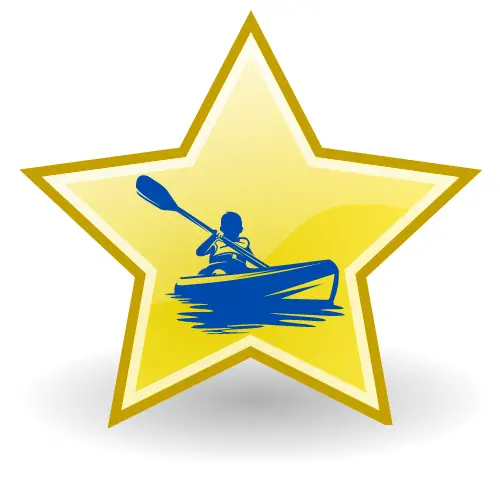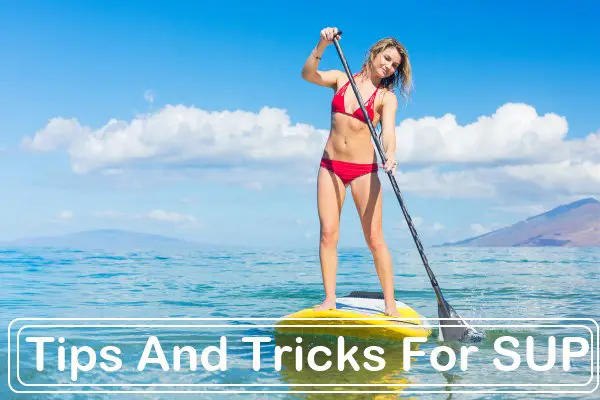If you’re new to paddleboarding, “Tips And Tricks For SUP Paddleboarding” can make your first experience more enjoyable and help you master the basics quickly. Despite the indisputable fact that standup paddle boarding is the easiest water sport in the world, it’s all the more reason to take your first steps in a fun way.
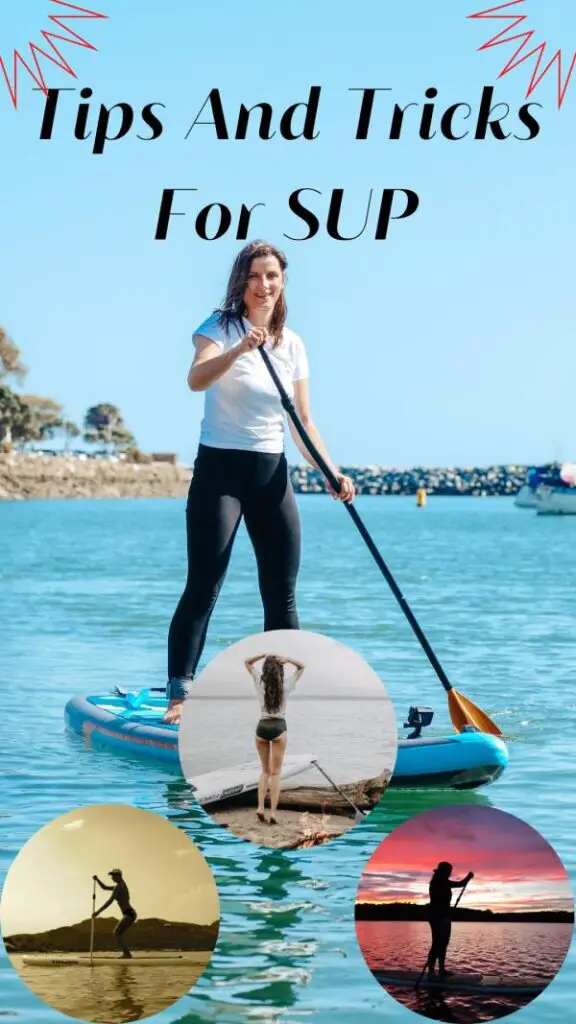
Table of Contents
SUP swimming equipment
SUP board a beginner should be wide, min. 80cm wide and the bigger displacement, min. 180-200 liters the better for people under 80kg, and for heavier one min. 270 liters of displacement (the displacement should be calculated 1:1 to kilograms and preferably the reserve for a beginner should be about three times our weight, so 50kg x 3 = 150 liters 80kg x 3 = 240 liters or 100kg x 3 = 300 liters) It will not be a problem if a child or a light woman starts on too large board but a heavy man on a too-small board may have a problem with swimming even in a sitting position, let alone to stand up.
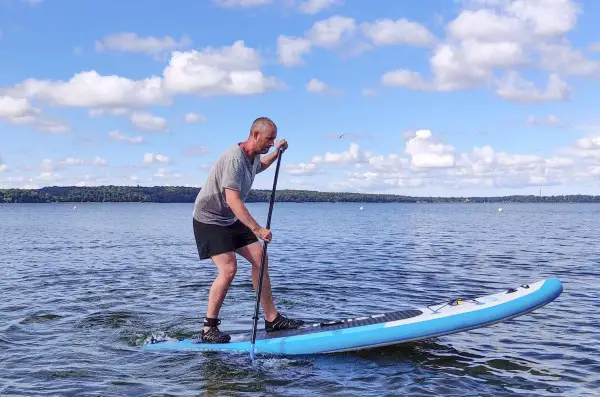
Paddle for SUP board should be 40cm longer than our height, to start with it is better to be too short than too long. We determine the length by resting the paddle with the feather (the part we paddle), at the same level in front of us. Holding the handle with the hand we pay attention that our arm is slightly bent at the elbow. Overbending the arm means that the paddle is too long, and if the hand is bent close to a right angle (90 degrees) it means that the paddle is too short.
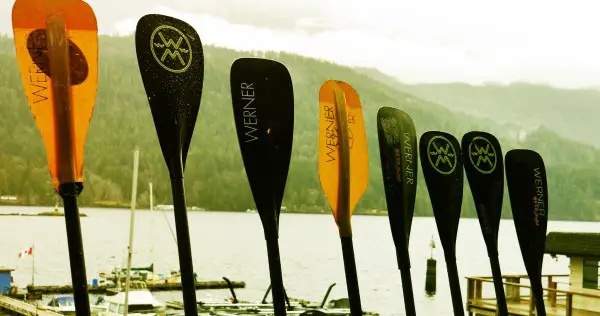
A vest to SUP is highly recommended, even mandatory for children, as it is for adults. Remember that in many areas in Poland swimming without a vest (on yourself or on the board) is prohibited and in case of an encounter with the water police, you may be fined.
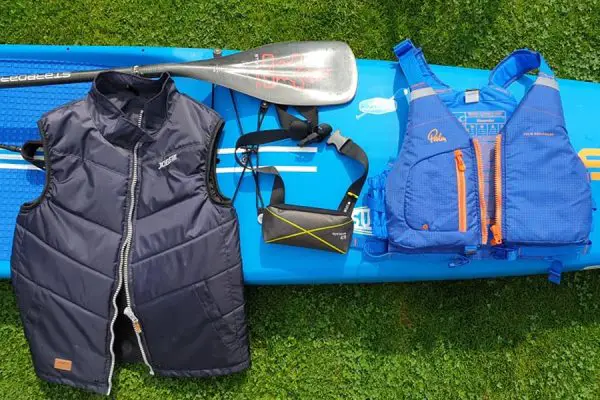
Leash a leg rope is not a gadget, but often more important than a vest, especially on rivers and waves. It makes sure that when you attach your SUP to the board (leg, above the ankle, or above the calf) you always have your SUP within “arm’s reach”, or here literally legs. On the river, it prevents us from chasing the board when it is swept away by the current, and on the waves, it prevents the board from bumping into others who have come to ride the waves with us.
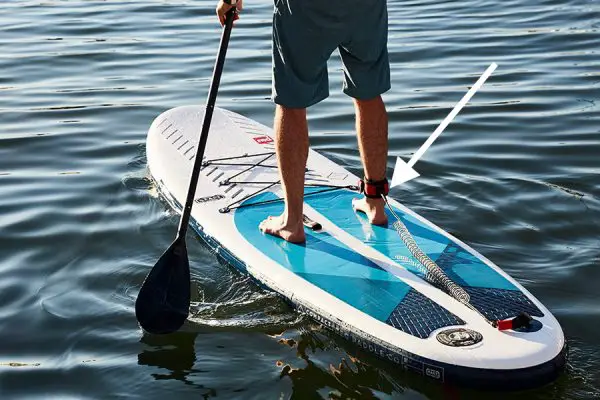
Where can I swim on a SUP?
For the first time, you should go to a calm body of water, necessarily on a windless day. Flat water, so-called “mirror water”, without the slightest wave and “standing air”, when not even a leaf on the tree is a dream for everyone swimming on SUP boards, especially for those starting their adventure. A calm body of water and a windless day is a must. Whether sitting, on your knees, or standing up, it will be easier to balance, feel the board, and get used to how the board reacts to our behavior, and position on it. You will quickly learn how to turn the board, and maybe after 15-30 minutes, you will be doing everything with your SUP board, not the other way around.
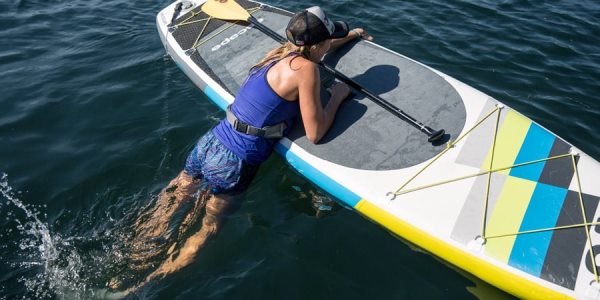
- Do not start on the sea on the waves, or rivers, maintaining balance even in a sitting position will be much more difficult, and the lack of feeling on the board, and the lack of ability to jump and turn can lead rivers to fall into various obstacles, and on the waves, for example in the Baltic Sea, we can easily and quickly enter our big board in other playing or swimming between the waves beach people.
- Rivers or waves, let’s leave for another step, and let’s swim at least 5-10 hours in easier places. About safety rules in swimming on the waves or rivers, we will soon write another article, because the knowledge on the subject is quite a lot, and the dangers of accidents in swimming on the lake are much, much greater
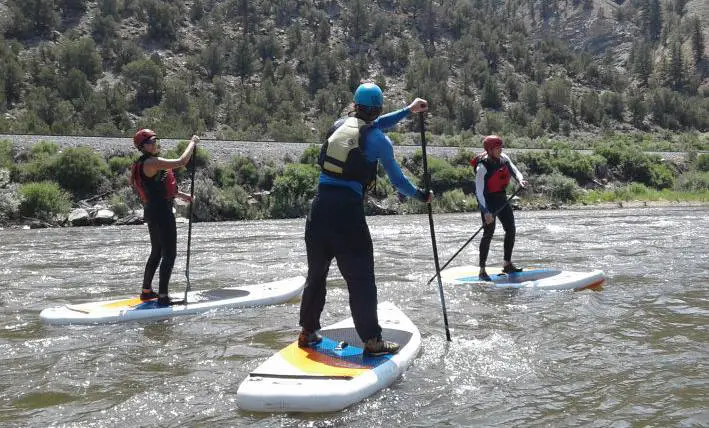
First SUP exercises
The most comfortable way to carry the board is to hold it by the handle in the middle of the board (inflatable boards – a piece of strap, wrapped in neoprene, rubber, composite boards – a hole, a cavity). For children or delicate women, it would be easier to carry the SUP with two people, one holding the bow and one holding the stern.
- Beware of the ballast (fin/centerboard), as in shallow waters it can be too long and will hook on the bottom. Therefore you should go into “knee-deep” with a tendency to do more than less. It is also about not breaking it when we get on the board and it slightly “sticks” and rests with the centerboard on the bottom.
- At first, we put the paddle across the board about 30-40cm in front of the handle and while keeping it leaning on the board we step onto the board with our knees and stay in a kneeling position. Then take the paddle in your hands and catch it lower. Do not hold the handle at the top, because it will be uncomfortable.
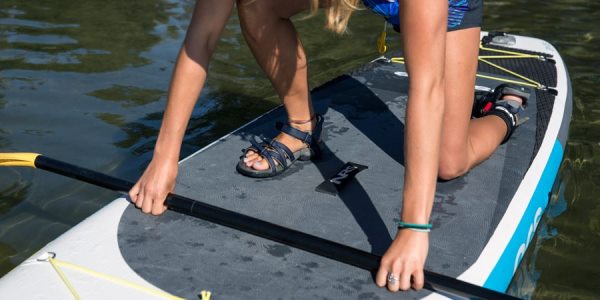
- Try to rock the board a little, swaying from side to side, to see how it reacts to moving your body weight from side to side (from side to side). Try to feel the board and get used to its quick reaction and “response” to our movements
- We paddle with the right side of the blade, i.e. bent forward (most beginners think it is the other way round, but more on that in the next article…) We should pay attention to putting the whole blade in the water, not just half or 1/3.
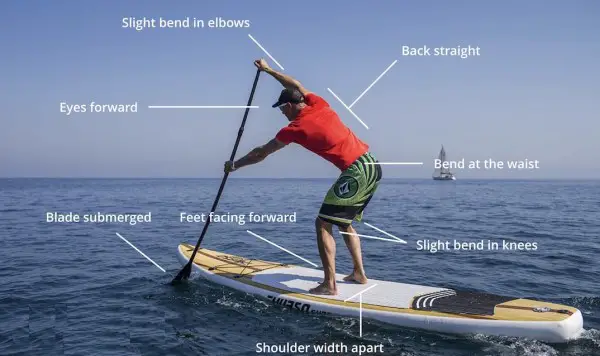
- Stopping, or putting the feather in the water and holding it firmly. This gives a lot of resistance and is like our brake, the board will lose speed and after a while will stop.
- Trying to turn, we paddle harder on one side, making stronger, longer movements, so we catch more water and the board starts to turn more violently. Alternatively, after 2-3 moves, put the paddle to the other side of the board, put it in the water, and hold still, or make 2-3 moves, backward
- After a while of trying to lift yourself up, but still remain in a kneeling position, now the center of gravity of your body will be a little higher and the board will react a little faster, and maintaining balance will be a little more difficult
- The next step is nothing more than an attempt to stand up, so again we rest the paddle across the board, and holding it we stand up first with one foot, then the other. We try to straighten up to the end.
In the beginning, we can slightly bend the legs in the knees, so that the center of gravity remains slightly lower than in a completely straight position.
If you’ve gotten to this stage faster than 5 minutes, you can consider yourself a SUP surfer who has a good aptitude for paddle boarding, without much trouble with balance and board feel. Float either pumped or composite boards, it’s up to you to decide which design suits you better or what you primarily want to do on your first SUP board.
FAQ
What are 3 important paddle boarding tips?
Certainly, here are three important tips for a successful paddleboarding experience:
Choose the Right Equipment:
Select the appropriate paddleboard for your skill level and intended use. Beginners should opt for wider, more stable boards, while experienced paddlers can choose narrower and faster models.
Ensure your paddle is the right length for your height, with the handle reaching your wrist when you stand the paddle next to you.
Wear a properly fitting personal flotation device (PFD) at all times, even in calm waters.
Start in Calm Conditions:
If you’re a beginner, begin your paddleboarding journey in calm and flat water, such as a lake or a sheltered bay. This will allow you to practice and build your skills without the challenges of waves and strong currents.
As you gain experience, you can gradually progress to more challenging conditions.
Prioritize Safety and Learn Self-Rescue:
Safety should be your top priority. Before heading out, inform someone on shore of your paddling plans, including your expected return time and route.
Learn self-rescue techniques, such as how to re-enter your board after a fall or a capsize. Practice these skills regularly to boost your confidence on the water.
By following these tips, you’ll enhance your paddleboarding experience and ensure a safe and enjoyable time on the water. As you gain confidence and experience, you can explore more advanced techniques and paddleboarding challenges.
How do you paddle efficiently on a sup?
Paddling efficiently on a Stand-Up Paddleboard (SUP) involves using proper technique to maximize your power and minimize effort. Here are some tips for efficient SUP paddling:
Stance and Posture:
Maintain a balanced and upright stance on the board with your feet hip-width apart.
Keep your knees slightly bent for flexibility and to absorb shock from small waves or ripples.
Grip and Hand Placement:
Hold the paddle with both hands, keeping a few inches of space between them.
Your top hand should be on the T-grip, and your bottom hand should be on the shaft.
Keep your arms straight during the stroke for better leverage.
Paddle Entry:
Reach forward with the paddle and immerse the blade fully in the water. The blade should enter smoothly and quietly, without splashing.
Start the stroke closer to the nose (front) of the board for maximum efficiency.
Powerful Stroke:
Focus on engaging your core muscles and rotating your torso with each stroke. The power should come from your hips and core, not just your arms.
Push the paddle through the water with a straight arm, extending it as far back as is comfortable for you.
Use your legs and hips to generate power, much like a twisting motion.
Paddle Exit:
As you pull the blade back, exit the water efficiently. Keep the blade close to the board during the exit to minimize drag.
The blade should exit the water near your feet.
Alternate Sides:
Alternate sides with each stroke to maintain a straight course and avoid overworking one side of your body.
To switch sides, take a few short, quick strokes to stabilize the board, then change the paddle to the other hand.
High Cadence:
Maintain a high cadence (stroke rate) to keep the board moving efficiently. Short, quick strokes are generally more effective than long, slow ones.
Relax and Breathe:
Keep your upper body and grip relaxed to reduce tension and fatigue.
Remember to breathe consistently and deeply to maintain your energy.
Look Ahead:
Keep your gaze focused on the horizon or the point where you want to go. This helps with balance and course direction.
Practice and Fitness:
Regular practice and physical fitness can improve your paddling efficiency over time.
Work on your cardiovascular endurance, strength, and flexibility to enhance your overall performance.
By following these tips and practicing your SUP paddling techniques, you can paddle more efficiently, cover longer distances with less effort, and enjoy a more enjoyable and rewarding experience on the water.
What are the four golden rules of getting on your sup?
When getting on your Stand-Up Paddleboard (SUP), there aren’t necessarily four golden rules, but there are essential steps to follow to ensure a safe and controlled entry onto the board. Here’s a step-by-step guide for getting on your SUP:
Prepare Your Equipment:
Ensure your board is in the water, and your paddle is within reach. Make sure your leash is securely attached to your ankle or calf.
Position the Board:
Place the board in shallow water where you can comfortably stand while getting on. Avoid rocky or uneven surfaces.
Stand Facing the Board:
Stand in the water facing the board. Position yourself alongside it, parallel to the board, with your knees slightly bent for balance.
Hold the Paddle:
Hold your paddle with both hands. One hand should be on the shaft, and the other on the T-grip.
Place the Paddle Across the Board:
Lay the paddle horizontally across the board, just in front of you. The paddle will provide stability as you get on.
Get on the Board:
Keeping your weight centered, place one knee on the board first. This knee will act as your pivot point.
While maintaining balance, bring your other knee onto the board to join the first one.
Once both knees are on the board, you should be in a kneeling position. Use the paddle for support if needed.
Begin Standing:
With both knees on the board, use the paddle to help you push up to a standing position.
Move from the kneeling position to a standing position slowly and smoothly.
As you rise to a standing position, maintain balance by keeping your feet hip-width apart and your knees slightly bent.
Grip the Paddle:
Once you’re standing on the board, adjust your grip on the paddle to be ready for paddling.
Balance and Center:
Focus on maintaining a balanced stance, keeping your core engaged for stability.
Start Paddling:
Begin paddling by taking your first strokes once you’re comfortable and stable on the board.
Remember that safety is paramount, and these steps should be followed carefully to ensure a controlled entry onto your SUP. If you’re new to paddleboarding, consider practicing these steps in shallow and calm water to build confidence and balance.
Is there a technique to paddle boarding?
Yes, there are specific techniques for stand-up paddleboarding (SUP) that can help you paddle more effectively, efficiently, and with greater control. Here are some essential techniques for paddleboarding:
Stance and Balance:
Stand in the center of the board with your feet parallel, about hip-width apart.
Keep your knees slightly bent to maintain balance and flexibility.
Distribute your weight evenly between both feet.
Grip and Control:
Hold the paddle with both hands, placing your top hand on the T-grip and your bottom hand on the shaft.
Your top hand should be above your head while your bottom hand rests at chest level.
Paddle Entry and Exit:
Ensure your paddle blade enters the water smoothly without splashing.
As you pull the blade back, exit the water without creating drag or splashes.
Basic Paddle Strokes:
Forward Stroke: Reach forward with your paddle, immerse the blade fully in the water, and pull it back to propel yourself forward. Alternate sides with each stroke.
Reverse Stroke: Push the paddle backward to slow down or reverse your direction.
Sweep Stroke: Use a wide sweeping motion to turn the board. Sweep on one side to turn in the opposite direction.
Draw Stroke: Reach out to the side with your paddle and pull it towards the board to move sideways.
Brace Stroke: Use a low brace (blade flat on the water) or high brace (blade angled away from the board) to maintain balance when you feel unstable.
Paddle Techniques:
Keep the paddle vertical in the water to maximize its efficiency.
Use your core muscles to generate power in your strokes, rather than relying solely on your arms.
Turning:
To turn to one side, take a few strokes on that side. A forward sweep on one side will turn the board in the opposite direction.
Paddling Conditions:
Begin in calm and flat water to practice your basic techniques. As you gain confidence, you can progress to more challenging conditions.
Leashes and Safety:
Always wear a leash to keep your board attached to you, enhancing safety and helping you retrieve the board if you fall.
Balance and Posture:
Maintain a balanced stance with your weight evenly distributed on the board.
Keep your eyes focused on the horizon to help with balance and orientation.
Safety and Etiquette:
Be aware of waterway rules and regulations, respect other water users, and follow safety guidelines.
Progression and Advanced Techniques: As you become more experienced, you can explore advanced techniques for specific activities such as touring, surfing, or racing.
Mastering these fundamental SUP techniques will provide a strong foundation for paddleboarding and help you paddle more efficiently and confidently. Regular practice and gradual progression are key to improving your skills on the water.
What should you not do when paddle boarding?
When paddleboarding, there are several things you should avoid to ensure safety, protect the environment, and have an enjoyable experience. Here are some “do not” guidelines for paddleboarding:
Do Not Neglect Safety Gear: Do not paddle without essential safety gear, including a properly fitting personal flotation device (PFD), a whistle, and signaling devices. Safety should be a top priority.
Do Not Overestimate Your Abilities: Avoid paddling in conditions or environments beyond your skill level. Overestimating your abilities can lead to accidents or challenging situations.
Do Not Disregard Weather Conditions: Do not disregard weather forecasts. Always check weather conditions and be prepared for changes on the water. Avoid paddling in adverse weather, especially strong winds and storms.
Do Not Disturb Wildlife: Do not disturb wildlife. Maintain a respectful distance from animals to avoid causing stress or harm to them.
Do Not Litter or Pollute: Do not litter in the water. Dispose of trash properly, and follow environmental ethics to minimize your impact on the environment.
Do Not Ignore Local Regulations: Be aware of and adhere to local paddleboarding regulations, such as no-wake zones, restricted areas, and specific safety requirements.
Do Not Lock Your Knees: Avoid locking your knees while paddleboarding. Keep your knees slightly bent to maintain balance and flexibility.
Do Not Forget Sun Protection: Do not neglect sun protection. Wear sunscreen, a hat, and sunglasses to prevent sunburn and glare.
Do Not Paddle in High-Traffic Areas: Avoid paddling in high-traffic areas where boats, jet skis, or other watercraft may pose risks to paddleboarders.
Do Not Panic in a Capsize: If you capsize, do not panic. Stay calm, follow safety procedures, and remember how to re-enter your paddleboard.
Do Not Paddle Alone in Remote Areas: Do not paddle alone in remote or unfamiliar areas. It’s safer to have a paddling partner in case of emergencies.
Do Not Skip Hydration: Stay hydrated by bringing water with you. Paddling can be physically demanding, and dehydration is a risk.
By following these “do not” guidelines, you can enhance your safety, protect the environment, and make the most of your paddleboarding experiences. Always remember to prioritize safety and enjoy the adventure responsibly.
What are the basic SUP techniques?
Stand-Up Paddleboarding (SUP) involves several basic techniques that are essential for getting started and having a successful experience on the water. Here are some fundamental SUP techniques to learn:
Paddling Stance:
Stand in the center of the board with your feet parallel, about hip-width apart.
Keep your knees slightly bent to maintain balance and flexibility.
Grip and Control:
Hold the paddle with both hands, placing your top hand on the T-grip and the bottom hand on the shaft.
Your top hand should be above your head while your bottom hand rests at chest level.
Basic Paddle Strokes:
Forward Stroke: Reach forward with your paddle, immerse the blade fully in the water, and pull it back to propel yourself forward. Alternate sides with each stroke.
Reverse Stroke: Push the paddle backward to slow down or reverse your direction.
Sweep Stroke: Use a wide sweeping motion to turn the board. Sweep on one side to turn in the opposite direction.
Draw Stroke: Reach out to the side with your paddle and pull it towards the board to move sideways.
Brace Stroke: Use a low brace (blade flat on the water) or high brace (blade angled away from the board) to maintain balance when you feel unstable.
Paddle Techniques:
Keep the paddle vertical in the water to maximize its efficiency.
Focus on using your core muscles to generate power in your strokes, rather than just your arms.
Turning:
To turn to one side, take a few strokes on that side. A forward sweep on one side will turn the board in the opposite direction.
Balance and Posture:
Maintain a balanced stance with your weight evenly distributed on the board.
Keep your eyes focused on the horizon to help with balance and orientation.
Paddle Entry and Exit:
Ensure your paddle blade enters the water smoothly and exits without splashing.
To minimize drag, keep the blade close to the board during the exit phase.
Leashes and Safety:
Always wear a leash to keep your board attached to you, which enhances safety and helps you retrieve the board if you fall.
Paddling Conditions:
Start in calm and flat water to practice your basic techniques. As you gain confidence, you can progress to more challenging conditions.
Safety and Etiquette:
Be aware of waterway rules and regulations, respect other water users, and follow safety guidelines.
Practice and Progression:
Regular practice and gradual progression are key to improving your SUP skills.
These basic SUP techniques provide a solid foundation for stand-up paddleboarding. As you become more experienced, you can explore advanced techniques for specific activities such as touring, surfing, or racing. Remember that safety and proper equipment are crucial for an enjoyable and secure SUP experience.
Should you lock your knees when paddle boarding?
No, you should not lock your knees while paddleboarding. Locking your knees can lead to instability and discomfort on the board. It’s important to maintain a relaxed and slightly bent knee position while paddleboarding for several reasons:
Balance: Keeping your knees slightly bent helps you maintain better balance on the board. If your knees are locked, you’ll have less flexibility to adjust your stance and respond to changes in the water or your body’s center of gravity.
Shock Absorption: Bent knees act as shock absorbers, helping you absorb the impact of small waves or ripples in the water. This can make your paddleboarding experience more comfortable and stable.
Maneuverability: Bent knees provide better maneuverability. You can shift your weight more effectively and make adjustments to your stance and paddle strokes when needed.
Comfort: Prolonged periods of locked knees can lead to discomfort or even cramping. Keeping your knees slightly bent can help you stay comfortable during your paddleboarding sessions.
Power and Paddle Control: Bent knees allow you to use your legs to help control the board and generate power during your paddle strokes. This can improve your efficiency and speed.
In summary, maintaining a relaxed stance with slightly bent knees is essential for balance, comfort, maneuverability, and overall performance while paddleboarding. It allows you to respond to the dynamics of the water and enjoy a more stable and enjoyable experience on the board.
Can I teach myself to SUP?
Yes, you can teach yourself to Stand-Up Paddleboard (SUP), but there are some important considerations to keep in mind to ensure a safe and effective learning experience:
Start with the Basics: Begin with the basics, such as getting comfortable with the board, practicing balance, and learning to paddle on calm and flat water.
Choose the Right Equipment: Select a stable and wide SUP board, especially if you’re a beginner. A longer board can be more stable and easier to balance on. Additionally, choose a suitable paddle that matches your height and style.
Safety First: Always wear a properly fitting personal flotation device (PFD) while paddleboarding. Safety should be a top priority.
Learn Paddle Technique: Study and practice proper paddle technique, including how to hold the paddle, how to perform basic strokes, and how to steer. You can find instructional videos and guides online to help you understand these techniques.
Body Position: Maintain a balanced and upright posture while paddleboarding. Keep your feet parallel and centered on the board to minimize drag.
Paddle in Calm Water: Start in calm, flat water conditions. Avoid strong currents, wind, or choppy waters until you gain more experience.
Practice Balance: Spend time practicing your balance on the board. Perform exercises like yoga poses or simply stand on one leg to improve your stability.
Take Your Time: Don’t rush your progression. Paddleboarding can take time to master. Focus on building your skills incrementally.
Online Resources: There are many online resources, including video tutorials and instructional articles, that can help you learn paddleboarding techniques and safety tips.
Paddle with a Buddy: If possible, paddle with a more experienced friend for added safety and guidance. Paddling with others can be enjoyable and reassuring.
Know Your Limits: Be aware of your limitations and avoid situations or conditions that exceed your skill level.
Respect the Environment: Follow environmental ethics and minimize your impact. Do not disturb wildlife or litter in the water.
While self-teaching can be an effective way to learn paddleboarding, especially for basic skills, taking a lesson from a certified instructor can provide valuable guidance and safety information. Lessons can help you progress more quickly and confidently. Whether you choose to self-teach or take lessons, always prioritize safety and enjoy the experience responsibly.
How do I get faster at paddleboarding?
Improving your speed in paddleboarding involves a combination of technique, fitness, and equipment considerations. Here are some tips to help you get faster at paddleboarding:
Proper Paddle Technique:
Focus on your paddle stroke technique. A proper paddle stroke will help you generate more power with each stroke.
Use your core muscles for rotation and engage your legs to provide extra power.
Maintain a high cadence (stroke rate) to keep the board moving efficiently.
Experiment with different paddle styles and lengths to find the one that suits you best.
Balance and Stance:
Maintain a balanced and stable stance on your board. A strong core and proper posture will help you paddle more efficiently.
Keep your feet parallel and centered on the board to minimize drag.
Fitness and Strength:
Build your strength and endurance, especially in your core and upper body muscles. Regular strength training and paddling-specific exercises can help you generate more power and sustain your effort.
Incorporate cardiovascular workouts to improve your overall fitness and stamina.
Practice Regularly:
Consistent practice is essential for improving your speed. Regularly paddle to build muscle memory and improve your technique.
Cross-Training:
Consider cross-training activities, such as swimming, which can enhance your cardiovascular fitness and overall strength.
Use the Right Equipment:
Invest in a high-quality paddleboard that suits your intended use and skill level. Racing or touring boards are designed for greater speed.
Ensure you have a high-performance paddle that’s lightweight and suits your height and style.
Reduce Drag:
Keep your board and gear clean and free of any unnecessary accessories that may create drag.
Maintain your board to ensure it’s in optimal condition.
Learn Drafting:
Drafting involves paddling closely behind another paddler, which can reduce the air resistance and help you go faster. Practice this technique with experienced paddlers.
Monitor Your Progress:
Use a GPS device or a fitness app to track your speed and distance during each session. Monitoring your progress can be motivating and help you set goals.
Nutrition and Hydration:
Pay attention to your nutrition and hydration. Proper fueling before and during your paddling sessions can contribute to better performance.
Mental Focus:
Maintain mental focus and stay motivated. Positive thinking and concentration on your goals can improve your speed.
Participate in Races and Events:
Consider participating in paddleboard races and events. Competing against others can push you to improve your speed and skills.
Getting faster at paddleboarding takes time and effort. Focus on refining your technique, improving your fitness, and using the right equipment to achieve your speed goals.
Our best posts:
